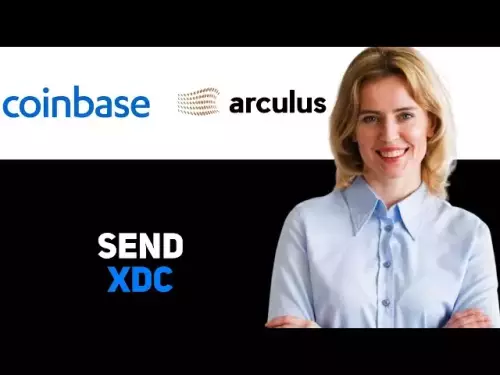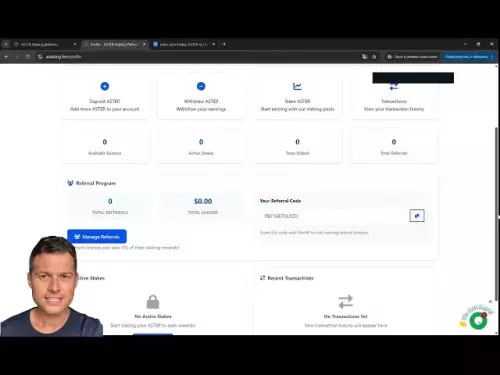-
 bitcoin
bitcoin $111375.742210 USD
-8.60% -
 ethereum
ethereum $3780.311592 USD
-13.98% -
 tether
tether $1.001299 USD
0.07% -
 bnb
bnb $1093.375857 USD
-13.01% -
 xrp
xrp $2.339375 USD
-16.91% -
 solana
solana $185.029017 USD
-16.69% -
 usd-coin
usd-coin $1.000230 USD
0.04% -
 tron
tron $0.319531 USD
-5.16% -
 dogecoin
dogecoin $0.190791 USD
-23.59% -
 cardano
cardano $0.638663 USD
-21.82% -
 ethena-usde
ethena-usde $0.998483 USD
-0.20% -
 hyperliquid
hyperliquid $37.741486 USD
-14.68% -
 chainlink
chainlink $17.229851 USD
-22.17% -
 stellar
stellar $0.316546 USD
-16.74% -
 bitcoin-cash
bitcoin-cash $507.861193 USD
-13.18%
Grid trading tutorial: How to set up automatic buying and selling? What varieties are suitable?
Grid trading profits in both bullish and bearish markets by setting buy/sell orders at intervals within a price range, ideal for volatile cryptocurrencies.
May 24, 2025 at 12:35 pm

Introduction to Grid Trading
Grid trading is an automated trading strategy that involves setting up buy and sell orders at regular intervals within a specified price range. This method aims to profit from the volatility of the cryptocurrency market by automatically executing trades as the price fluctuates. The key advantage of grid trading is its ability to generate profits in both bullish and bearish markets, making it an attractive strategy for many traders.
How to Set Up Grid Trading
Setting up a grid trading system requires careful planning and execution. Here is a detailed step-by-step guide to help you get started:
Choose a Suitable Trading Platform: Not all trading platforms support grid trading. Popular platforms that do include Binance, KuCoin, and Bybit. Ensure you select a platform that offers this feature.
Select a Cryptocurrency Pair: Decide which cryptocurrency pair you want to trade. Popular pairs include BTC/USDT, ETH/USDT, and others. The choice depends on your market analysis and risk tolerance.
Define the Price Range: Determine the upper and lower bounds of the price range within which your grid will operate. For example, if you are trading BTC/USDT and the current price is $30,000, you might set a range from $28,000 to $32,000.
Set the Grid Interval: Decide on the number of grids and the interval between each grid. If you choose a range of $4,000 with 10 grids, each grid interval would be $400.
Determine the Investment Amount: Allocate the total amount of funds you wish to invest in the grid. This amount will be distributed across the grids based on the number of orders.
Configure the Grid: Use the trading platform's grid trading tool to input your parameters. Set the upper and lower bounds, the number of grids, and the investment amount. The platform will automatically calculate the buy and sell orders for each grid.
Review and Activate: Double-check all settings to ensure they align with your strategy. Once satisfied, activate the grid trading system.
Understanding Grid Trading Parameters
To effectively set up a grid trading system, it's crucial to understand the various parameters involved:
Upper and Lower Bounds: These define the price range within which the grid operates. Choosing a wider range can capture more price movements but may also increase risk.
Number of Grids: This determines how many buy and sell orders are placed within the range. More grids can lead to more frequent trades but may also increase transaction costs.
Grid Interval: The price difference between each grid. A smaller interval means more granular trading but also more orders to manage.
Investment Amount: The total funds allocated to the grid. This amount is distributed across all grids, affecting the size of each trade.
Suitable Cryptocurrencies for Grid Trading
Not all cryptocurrencies are suitable for grid trading. Here are some factors to consider when selecting a cryptocurrency pair:
Liquidity: High liquidity ensures that orders can be executed quickly and at desired prices. Popular pairs like BTC/USDT and ETH/USDT are highly liquid.
Volatility: Grid trading thrives on volatility. Cryptocurrencies with moderate to high volatility are ideal, as they provide more opportunities for price movements within the grid range.
Trading Volume: Higher trading volumes indicate more active markets, which can lead to better execution of grid orders.
Market Trends: Understanding the current market trend can help in setting the grid range. For instance, in a bullish market, setting the grid with a higher upper bound might be more beneficial.
Risks and Considerations in Grid Trading
While grid trading can be profitable, it also comes with certain risks that traders should be aware of:
Market Risk: The cryptocurrency market is highly volatile, and prices can move outside the grid range, resulting in potential losses.
Transaction Costs: Frequent trading can lead to high transaction fees, which can eat into profits. It's important to consider these costs when setting up the grid.
Over-Optimization: Setting too many grids or too narrow an interval can lead to over-optimization, where the system becomes too sensitive to minor price movements.
Technical Failures: Reliance on automated systems means that technical failures can disrupt trading. Ensure that the trading platform you use is reliable and has good customer support.
Optimizing Grid Trading Strategies
To maximize the effectiveness of your grid trading strategy, consider the following optimization techniques:
Dynamic Grid Adjustment: Some platforms allow for dynamic adjustment of the grid range based on market conditions. This can help adapt to changing market trends and potentially increase profitability.
Profit-Taking and Stop-Loss Settings: Implementing profit-taking and stop-loss orders within the grid can help manage risk. Set these levels based on your risk tolerance and market analysis.
Backtesting: Before deploying a grid trading strategy with real funds, backtest it using historical data to see how it would have performed in the past. This can help fine-tune parameters and improve the strategy.
Diversification: Spread your grid trading across multiple cryptocurrency pairs to reduce risk and potentially increase returns. Diversification can help mitigate the impact of poor performance in any single pair.
Frequently Asked Questions
Q: Can I use grid trading on any cryptocurrency exchange?A: No, grid trading is not supported by all cryptocurrency exchanges. It's essential to check if the platform you are using offers this feature before setting up a grid trading system.
Q: How often should I monitor my grid trading system?A: While grid trading is automated, it's advisable to monitor your system regularly, at least daily, to ensure it's operating as expected and to make any necessary adjustments based on market conditions.
Q: Is grid trading suitable for beginners?A: Grid trading can be complex and requires a good understanding of the market and trading strategies. While beginners can use it, they should start with small investments and thoroughly educate themselves on the strategy and its risks.
Q: Can I combine grid trading with other trading strategies?A: Yes, many traders combine grid trading with other strategies like trend following or scalping. This can help diversify your trading approach and potentially increase profitability, but it also adds complexity and requires careful management.
Disclaimer:info@kdj.com
The information provided is not trading advice. kdj.com does not assume any responsibility for any investments made based on the information provided in this article. Cryptocurrencies are highly volatile and it is highly recommended that you invest with caution after thorough research!
If you believe that the content used on this website infringes your copyright, please contact us immediately (info@kdj.com) and we will delete it promptly.
- XRP Price Prediction: Weekend Rollercoaster or Rally?
- 2025-10-12 08:45:16
- Bittensor (TAO): Super Bullish Signals Point to Potential 2x Rally
- 2025-10-11 10:25:12
- Silver Price Correction: Navigating the Dip & Identifying Key SEO Keywords
- 2025-10-11 10:25:12
- Decoding Crypto Trends: Bittensor's Bull Run, Cardano's Dip, and LivLive's Presale Buzz in 'Uptober 2025'
- 2025-10-12 08:45:16
- MoonBull: The Crypto Meme Coin Promising 1000x Gains?
- 2025-10-11 10:30:01
- Crypto Payroll Revolution: Stablecoins, Altcoins, and the Future of Salary Payments
- 2025-10-11 10:30:01
Related knowledge

Practical parameter settings for a Bitcoin multi-timeframe moving average system
Sep 18,2025 at 10:54pm
Optimizing Timeframe Combinations for Bitcoin Trading1. Selecting appropriate timeframes is crucial when building a multi-timeframe moving average sys...

How can I filter out false breakouts in Dogecoin high-frequency trading?
Sep 22,2025 at 01:00am
Understanding False Breakouts in Dogecoin Trading1. A false breakout occurs when Dogecoin's price appears to move beyond a defined support or resistan...

Techniques for identifying tops and bottoms in the Bitcoin on-chain NVT model
Sep 20,2025 at 07:54pm
Understanding the NVT Model in Bitcoin Analysis1. The Network Value to Transactions (NVT) ratio is often described as the 'P/E ratio' of the cryptocur...

What does the surge in open interest in Bitcoincoin futures mean?
Sep 20,2025 at 11:18pm
Understanding the Surge in Dogecoin Futures Open Interest1. A surge in open interest within Dogecoin futures indicates a growing number of active cont...

How can I use the Ethereum USDT premium to gauge market sentiment?
Sep 18,2025 at 11:55pm
Understanding the Ethereum USDT Premium1. The Ethereum USDT premium refers to the price difference between USDT (Tether) traded on Ethereum-based plat...

What should I do if Ethereum staking yields decline?
Sep 20,2025 at 06:18am
Understanding the Causes Behind Declining Ethereum Staking Yields1. The Ethereum network transitioned to a proof-of-stake consensus mechanism with the...

Practical parameter settings for a Bitcoin multi-timeframe moving average system
Sep 18,2025 at 10:54pm
Optimizing Timeframe Combinations for Bitcoin Trading1. Selecting appropriate timeframes is crucial when building a multi-timeframe moving average sys...

How can I filter out false breakouts in Dogecoin high-frequency trading?
Sep 22,2025 at 01:00am
Understanding False Breakouts in Dogecoin Trading1. A false breakout occurs when Dogecoin's price appears to move beyond a defined support or resistan...

Techniques for identifying tops and bottoms in the Bitcoin on-chain NVT model
Sep 20,2025 at 07:54pm
Understanding the NVT Model in Bitcoin Analysis1. The Network Value to Transactions (NVT) ratio is often described as the 'P/E ratio' of the cryptocur...

What does the surge in open interest in Bitcoincoin futures mean?
Sep 20,2025 at 11:18pm
Understanding the Surge in Dogecoin Futures Open Interest1. A surge in open interest within Dogecoin futures indicates a growing number of active cont...

How can I use the Ethereum USDT premium to gauge market sentiment?
Sep 18,2025 at 11:55pm
Understanding the Ethereum USDT Premium1. The Ethereum USDT premium refers to the price difference between USDT (Tether) traded on Ethereum-based plat...

What should I do if Ethereum staking yields decline?
Sep 20,2025 at 06:18am
Understanding the Causes Behind Declining Ethereum Staking Yields1. The Ethereum network transitioned to a proof-of-stake consensus mechanism with the...
See all articles










































































